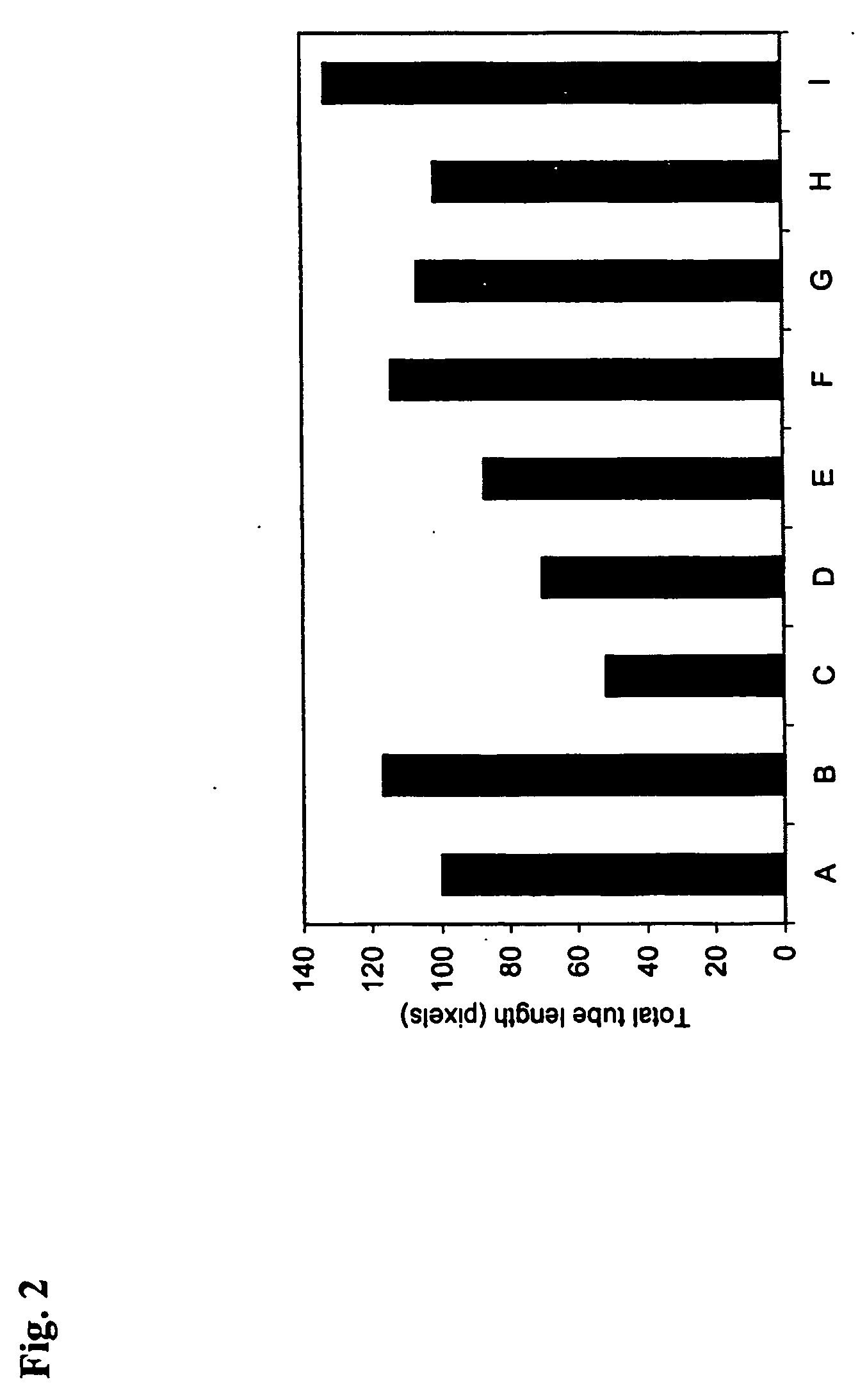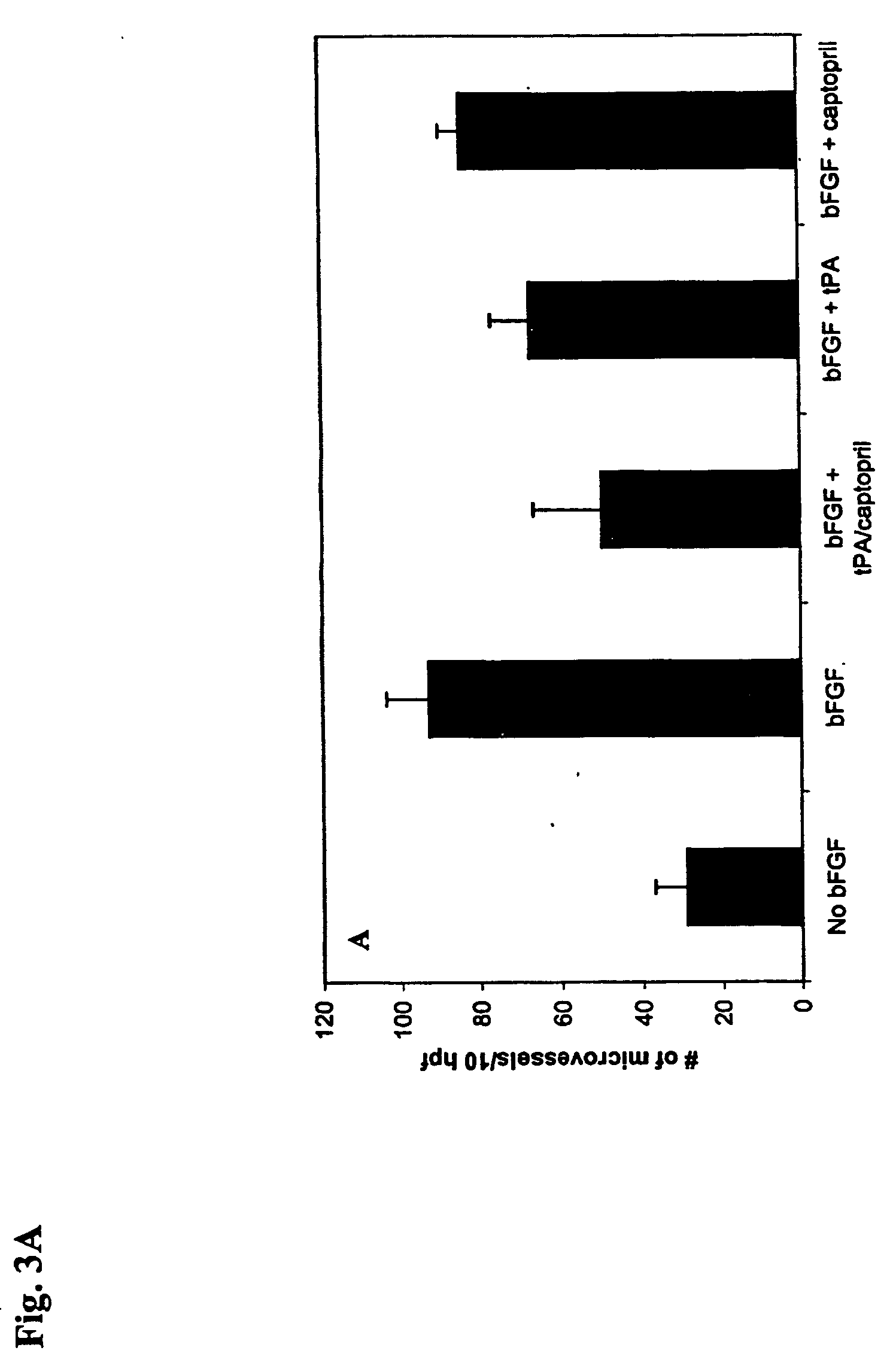Protease activity of thrombin inhibits angiogenesis
- Summary
- Abstract
- Description
- Claims
- Application Information
AI Technical Summary
Benefits of technology
Problems solved by technology
Method used
Image
Examples
example 1
In Vitro and In Vivo Induction of Antiangiogenic Activity by Plasminogen Activators and Captopril
[0089] In vitro exposure of human fresh frozen plasma to rt-PA and captopril induced significant in vitro antiangiogenic activity as assessed by the matrigel tube formation assay (FIG. 1 and FIG. 2). Pharmacokinetic studies have shown that plasma concentrations of 0.1 to 1 μM are achieved by doses of captopril of 25 to 37.5 mg three times a day. Plasma concentrations of tissue plasminogen activator in healthy volunteers and patients treated for myocardial infarction are in the range of 0.5 to 1.8 μg / ml receiving doses of 0.004 mg / kg / min. The concentrations used in our assays are within this range. The in vitro findings were extended to the in vivo setting by treatment of a patient with metastatic sarcoma with captopril and low dose rt-PA. A potent antiangiogenic effect was induced in her plasma (FIGS. 4 and 5). The demonstration that the treated patient's plasma inhibited endothelial ce...
example 2
Protease Activity of Thrombin Inhibits Angiogenesis
[0112] We have discovered that treatment of whole human plasma with tPA in combination with captopril in vitro resulted in the generation of an antiangiogenic activity. However, the induced antiangiogenic moiety in this treated plasma was unlikely to be angiostatin, as removal of angiostatin by either immunodepletion or lysine Sepharose chromatography did not diminish the antiangiogenic activity present in the tPA / captopril-treated plasma. Here we describe a series of steps to purify and identify the protein with this novel antiangiogenic activity.
[0113] We have developed an efficient three-column scheme. First, the treated plasma is subjected to anion exchange chromatography, yielding a fraction that contains most of the antiangiogenic activity (FIG. 10D) but accounts for <2% of the input proteins. Interestingly, the potency of this fraction (and the active fractions from the later columns) is more than that of the tPA / captopril-...
example 3
Identification of Compounds that Modulate uPA-uPA-R Biological Activity
[0137] There has been controversy in the art regarding the effects of proteases in tumor growth and progression. Based upon our results, we believe that overexpression of proteases of the plasminogen activator family (e.g., urokinase and tissue plasminogen activator) by the tumor may prevent or delay tumor growth, metastases, and improve survival.
[0138] While not wishing to be bound by a particular mechanism, we believe these proteases may degrade fibrin, known to occur in the matrix of many tumors and which is known to favor angiogenesis and support tumor cell growth. The goals of the experiments performed were to determine the effects of tumor overexpression of uPA, tPA and a mutant form of uPA, which does not bind to its receptor, but preserves the proteolytic activity.
[0139] Construction of mutant uPA clones and cell transfection. We chose to pursue a genetic approach, in which we stably transfected an agg...
PUM
| Property | Measurement | Unit |
|---|---|---|
| Time | aaaaa | aaaaa |
| Composition | aaaaa | aaaaa |
| Biological properties | aaaaa | aaaaa |
Abstract
Description
Claims
Application Information
 Login to View More
Login to View More - R&D
- Intellectual Property
- Life Sciences
- Materials
- Tech Scout
- Unparalleled Data Quality
- Higher Quality Content
- 60% Fewer Hallucinations
Browse by: Latest US Patents, China's latest patents, Technical Efficacy Thesaurus, Application Domain, Technology Topic, Popular Technical Reports.
© 2025 PatSnap. All rights reserved.Legal|Privacy policy|Modern Slavery Act Transparency Statement|Sitemap|About US| Contact US: help@patsnap.com



